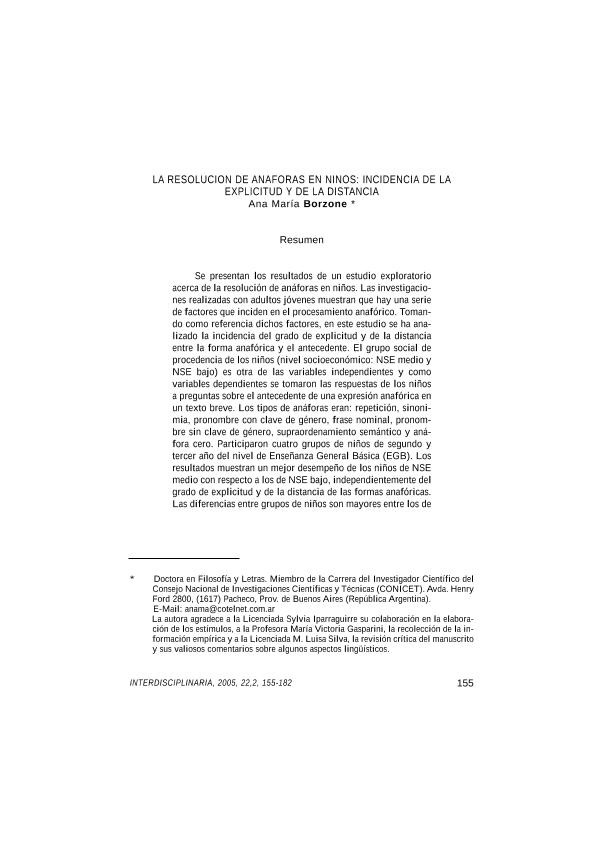Mostrar el registro sencillo del ítem
dc.contributor.author
Borzone, Ana Maria

dc.date.available
2020-06-03T19:34:34Z
dc.date.issued
2005-12
dc.identifier.citation
Borzone, Ana Maria; La resolución de anáforas en niños: incidencia de la explicitud y de la distancia; Centro Interamericano de Investigaciones Psicológicas y Ciencias Afines; Interdisciplinaria; 22; 2; 12-2005; 155-182
dc.identifier.issn
0325-8203
dc.identifier.uri
http://hdl.handle.net/11336/106624
dc.description.abstract
Se presentan los resultados de un estudio exploratorio acerca de la resolución de anáforas en niños. Las investigaciones realizadas con adultos jóvenes muestran que hay una serie de factores que inciden en el procesamiento anafórico. Tomando como referencia dichos factores, en este estudio se ha analizado la incidencia del grado de explicitud y de la distancia entre la forma anafórica y el antecedente. El grupo social de procedencia de los niños (nivel socioeconómico: NSE medio y NSE bajo) es otra de las variables independientes y como variables dependientes se tomaron las respuestas de los niños a preguntas sobre el antecedente de una expresión anafórica en un texto breve. Los tipos de anáforas eran: repetición, sinonimia, pronombre con clave de género, frase nominal, pronombre sin clave de género, supraordenamiento semántico y anáfora cero. Participaron cuatro grupos de niños de segundo y tercer año del nivel de Enseñanza General Básica (EGB). Los resultados muestran un mejor desempeño de los niños de NSE medio con respecto a los de NSE bajo, independientemente del grado de explicitud y de la distancia de las formas anafóricas. Las diferencias entre grupos de niños son mayores entre los de segundo año. En tercero, en ambos grupos se observan porcentajes de respuestas correctas superiores al 90%, excepto en el caso de anáfora sin clave de género. Se observa la incidencia del grado de explicitud de la forma anafórica y de la distancia en aquellas formas cuya resolución presenta dificultades. La anáfora cero no resulta difícil de resolver para los grupos estudiados.
dc.description.abstract
The present work aims to explore children's abilities to resolve anaphoric expressions. Anaphors are linguistic devices used to refer to previously mentioned concepts. Most of the studies on this subject were conducted to understand how adult deal with anaphors. It was observed that several factors can influence the relative accessibility of antecedent information and the ease of anaphor resolution, among them the degree of explicitness (Gernsbacher, 1990) and the distance between the anaphors and its antecedents (Carreiras, Garnham, & Oakhill, 1996). Explicitness refers to the degree to which anaphors share features with the appropriate antecedent. Anaphors can take many forms ranging along a continuum in terms of this factor. In several experiments it was found that explicit anaphors are resolved more quickly and easily than less explicit anaphors. Within the framework of comprehension models it was postulated that the information of the anaphors, their explicitness, controls how rapidly and powerfully they trigger suppression and enhancement (Gernsbacher, 1990). With respect to distance, its influence may be due to the mechanisms of suppression triggered by other concepts introduced between the anaphor and its referent (O'Brien et al., 1997). The purpose of this study is to start exploring anaphor resolution in young Spanish speaking children considering the influence of explicitness and distance. It also aims to examine the differences, if any, on comprehension skills between children from middleincome homes and from low-income families since it has been shown that children raised in poverty often have limited exposure to books. The limited experience may have a negative effect on children's comprehension performance. Two groups of second and two groups of third grades children, one from low-income and one from middle-income families in each grade, participated in the study. Twenty one experimental texts were constructed, three texts for each anaphoric expression: repetition, noun phrase, synonym, gender-explicit pronoun, gender-ambiguous pronoun, semantic superordinate and zero anaphor. Three versions of each text were written to get three levels of distance between the potential anaphor and the antecedent. The versions were formed by two sentences, three sentences and four sentences being the antecedent in the first sentence and the anaphor in the last one. At the end of each text a question was presented about the referent of the action or state mentioned in the last sentence. Children were tested individually. The texts and the questions were read to them. Results showed that groups from middle-income families had a better performance than groups from low-income ones. This difference was statistically significant between the second grade groups in the responses to all the anaphoric expressions, except in the case of the repeat anaphor; between the third grade groups the difference was only significant in genderambiguous pronouns. The distance between the anaphor and its referent had no systematic effect on children's performance. These results may be due to the fact that the task was not very demanding and allowed sufficient computation time (Long,& Logan, 2000). On the contrary, the influence of explicitness was apparent in the responses of all groups of children; this factor especially affected the performance of second grade group from low-income homes. Gender-ambiguous pronouns were very difficult to resolve for all children. Overall results suggest that children had not developed enough processing abilities to use information from the various sources that contribute to the resolution of anaphoric expressions.
dc.format
application/pdf
dc.language.iso
spa
dc.publisher
Centro Interamericano de Investigaciones Psicológicas y Ciencias Afines
dc.rights
info:eu-repo/semantics/openAccess
dc.rights.uri
https://creativecommons.org/licenses/by-nc/2.5/ar/
dc.subject.classification
Lingüística

dc.subject.classification
Lengua y Literatura

dc.subject.classification
HUMANIDADES

dc.title
La resolución de anáforas en niños: incidencia de la explicitud y de la distancia
dc.title
The resolution of anaphoric expressions by children: The influence of expliciitness and distance
dc.type
info:eu-repo/semantics/article
dc.type
info:ar-repo/semantics/artículo
dc.type
info:eu-repo/semantics/publishedVersion
dc.date.updated
2020-05-05T16:36:32Z
dc.identifier.eissn
1668-7027
dc.journal.volume
22
dc.journal.number
2
dc.journal.pagination
155-182
dc.journal.pais
Argentina

dc.journal.ciudad
Ciudad Autónoma de Buenos Aires
dc.description.fil
Fil: Borzone, Ana Maria. Consejo Nacional de Investigaciones Científicas y Técnicas. Oficina de Coordinación Administrativa Saavedra 15. Centro Interdisciplinario de Investigaciones en Psicología Matemática y Experimental Dr. Horacio J. A. Rimoldi; Argentina
dc.journal.title
Interdisciplinaria
dc.relation.alternativeid
info:eu-repo/semantics/altIdentifier/url/http://ref.scielo.org/fynh2t
dc.relation.alternativeid
info:eu-repo/semantics/altIdentifier/url/https://www.redalyc.org/articulo.oa?id=18022203
Archivos asociados
